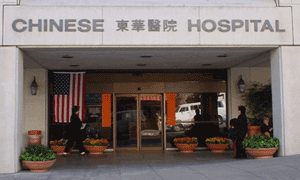Entrance to San Francisco Chinese Hospital, one of California’s top performers.
By CHAD TERHUNE
Nearly half of California hospitals received a grade of C or lower for patient safety on a national report card aimed at prodding medical centers to do more to prevent injuries and deaths.
The Leapfrog Group, an employer-backed nonprofit group focused on healthcare quality, issued its latest scores last week. The report card is part of an effort to make consumers and employers aware of how their hospitals perform on key quality measures, so they can make better-informed health care decisions. The scores are updated twice a year, in spring and fall.
After steady improvement in recent years, California hospitals lost ground in last week’s report card. Two years ago, 37 percent of California hospitals received a C, D or F grade. That increased to 46 percent of the 271 California hospitals rated in the most recent report.
Many California hospitals still struggle to reduce preventable medical errors and infections in patients, despite industrywide efforts to remedy those problems. California accounted for 6 of the 10 hospitals nationwide that received an F grade.
California public health officials track a wide assortment of patient infections that can be acquired during a hospital stay. A recent state report noted progress in some areas, while other issues have been harder to address.
From 2014 to 2015, 56 California hospitals achieved “significant improvement” in preventing certain infections, including ones in the blood and those resulting from surgery, according to the California Department of Public Health. But diarrheal infections in California hospitals have increased 8 percent above a national benchmark since 2011.
The state has created an interactive map where the public can check infection rates by hospital.
Leapfrog, which has issued hospital scores in California and nationwide since 2012, analyzes information it collects as well as data reported to Medicare. Erica Mobley, a Leapfrog spokeswoman, said the group’s methodology compares all hospitals to each other on a national scale, so a mix of factors could be responsible for the lower scores statewide.
“This could represent California hospitals’ performance slipping in comparison to their peers across the country or could also mean that they may be staying constant in their performance while other hospitals are progressing,” Mobley said.
The percentage of hospitals in the Golden State that got the top rating also decreased in Leapfrog’s latest analysis. Twenty-five percent of California hospitals, 68 facilities, earned an A grade this year, compared to 43 percent, or 104, in 2015.
California ranked 28th nationally in the percentage of A-rated hospitals. More than half of the hospitals in states such as Oregon, North Carolina and Massachusetts achieved the highest score.
In Leapfrog’s report card, some performance measures are risk-adjusted for patient severity and income so hospitals aren’t penalized for admitting sicker, poorer patients.
Some hospital industry officials have criticized Leapfrog’s letter grades as too simplistic for a complex issue and as potentially misleading for patients.
Jan Emerson-Shea, a spokeswoman for the California Hospital Association, noted there are many different scorecards and said consumers shouldn’t put too much stock in any one ranking.
“While these scorecards often serve as a good starting point for patients to ask questions of their health-care provider, they should not be viewed as being a definitive source for determining the quality of care provided by any hospital,” Emerson-Shea said.
The Leapfrog data show that some of the top performers in California include San Francisco Chinese Hospital, Mercy General Hospital, in Sacramento, Hoag Memorial Hospital Presbyterian, in Newport Beach, and Inglewood’s Centinela Hospital Medical Center.
Health giant Kaiser Permanente consistently posts some of the highest scores and shows little variation across its 35 hospitals in the state. Thirty-three Kaiser hospitals received A or B grades; two got C grades.
The University of California health system fared well across seven hospital campuses, with five A ratings and two B grades.
Some large institutions lagged further behind. Providence St. Joseph Medical Center, in Burbank, received a D, as did the Zuckerberg San Francisco General Hospital and Trauma Center.
Leapfrog cited San Francisco General, a public safety-net hospital, for being below average at preventing surgical site infections after colon surgery and for allowing dangerous objects to be left in a patient’s body, among other factors. Providence’s Burbank hospital had a higher-than-expected rate of patients who developed serious breathing problems and caught antibiotic-resistant infections, according to Leapfrog.
A spokesman for San Francisco General didn’t comment directly on the hospital’s results, other than to say it didn’t participate in Leapfrog’s optional survey on safety procedures and training.
Providence said in a statement it takes patient safety seriously and respects efforts to help consumers make an informed choice. However, “it is important to understand that health care data are extremely difficult to compare as each patient is unique,” the hospital said. “Often information is a few years old before it is analyzed and aggregated for the public.”
California’s Office of Statewide Health Planning and Development also offers data on hospital quality and patient outcomes. And Medicare posts star ratings for hospitals nationwide, which are another resource for patients and policymakers.




